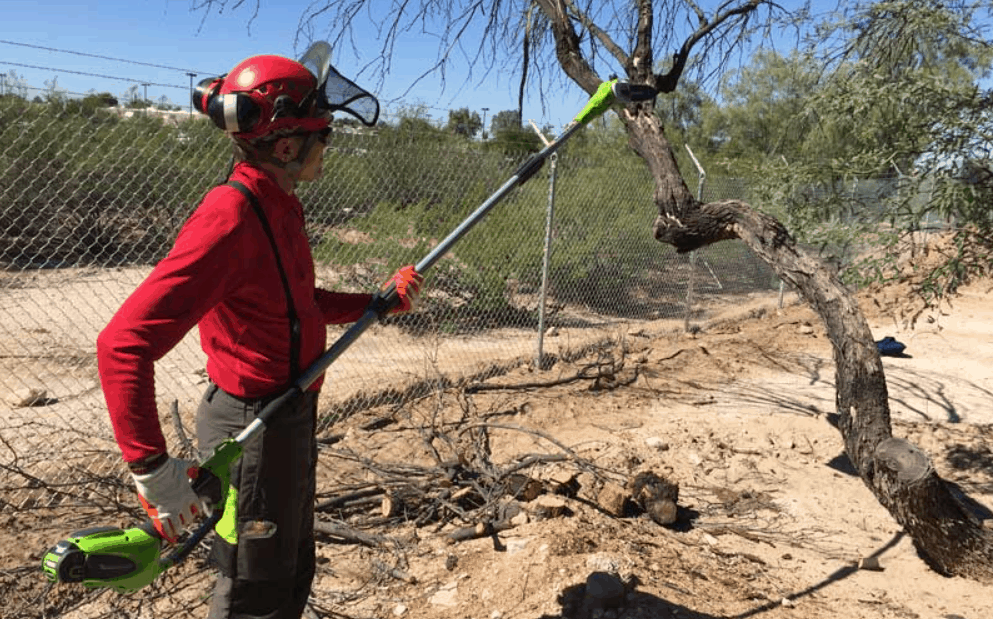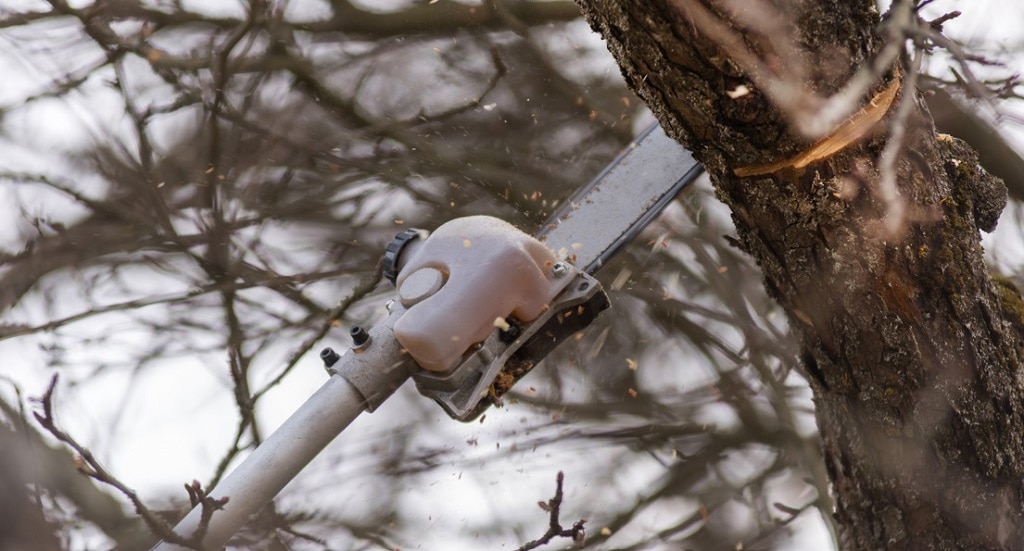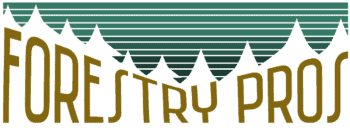- Best Ripping Chainsaw Chains Guide - December 5, 2023
- Longest Pole Saws Guide - October 20, 2022
- Common Stihl 462 Problems & Troubleshooting - October 18, 2022
If you are looking for the easiest way to trim tree branches, a pole saw is the way to go.
Pole saws are an excellent tool for trimming branches and trees. They provide a safe way to cut tall branches from a distance and are more efficient than ladders and chainsaws. They have the length you need, especially for cutting a few significant branches that would otherwise require a step ladder. If you just got your new pole saw, but don’t exactly know how to use it, don’t worry; I got you!
As an avid DIYer, I will provide a step-by-step guide on how to use a pole saw safely and effectively, along with some safety precautions and bonus tips.
Let’s get started!
Bottom Line Up Front
Using a pole saw is relatively simple. Just position the blade where you want to make the cut and then push or pull the saw through the wood. Be sure to wear gloves and eye protection when using a pole saw.
Pole-mounted saws are similar to using any other hand saw: you move the blade manually back and forth across the object. There are also more powerful electric and gas pole saws available, and while I’ll get into each type in detail below, I will say that my favorite pole saw is the PROYAMA Multi-Function Pole Saw. It’s a powerful tool that comes with everything you need.
Types of Pole Saw

Pole saws come in different shapes and sizes, each designed for a specific purpose. Here are the most common types of pole saws:
- Standard Pole Saw: The standard pole saw is the most basic type. It consists of a long pole with a small hand saw at the end. These types of pole saws are ideal for trimming branches that are within reach.
- Extendable Pole Saw: The extendable pole saw has an extending handle that allows you to reach higher branches. These types of pole saws are ideal for trimming taller trees.
- Chainsaw Pole Saw: The chainsaw pole saw is the most powerful type of pole saw. It consists of a long bar with a chainsaw at the end. These types of pole saws are ideal for trimming thick branches.
- Electric Pole Saw: The electric pole saw is similar to the standard pole saw but has an electric motor. These types of pole saws are ideal for trimming branches that are within reach.
- Gasoline Pole Saw: The gasoline pole saw is similar to the standard pole saw but has a gasoline-powered engine. These types of pole saws are ideal for trimming thicker branches.
Safety Precautions
There are many things that you have to keep in mind before pruning or trimming the wood. Cutting down branches that are not within reach is extremely risky. During the process, the wood falls uncontrollably, which can cause damage, injury, or even death to a person. So, to prevent such a situation, here are some safety precautions you must strictly follow:
- Read the manual: It might seem like a no-brainer, but you’d be surprised how many people try to operate a chainsaw without first reading the manual. Please familiarize yourself with the saw’s features and how to use them properly.
- Wear the proper gear: This includes eye protection, gloves, hearing protection, and sturdy shoes or boots. Don’t try to operate the saw while wearing loose clothing that could get caught in the chain.
- Inspect the saw before each use: Ensure that the chain is tensioned correctly and that there are no loose parts.
- Keep the saw clean: A buildup of sawdust can cause the saw to overheat and malfunction. Please make sure you always keep it clean.
- Use the saw only for its intended purpose: Please don’t force it to do something it wasn’t designed to do.
- Be aware of your surroundings: Make sure there are no obstacles in your path that could cause you to trip or lose control of the saw.
- Never cut above your head: Be extra careful when cutting branches above your head. The branch could fall and injure you or someone else nearby.
- Take breaks often to avoid fatigue: Do not overwork yourself. It is essential when you’re working in hot weather.
- Never leave the saw running unattended: Turn it off and unplug it when you’re not using it.
How to use a Pole Saw

Here are the step-by-step guidelines for using a pole saw:
Step 1: Clear the workspace
- Clear a large work area below the branch from all people and property.
- Then secure the zone; make sure no one enters the space.
- Take note of exposed roots and remove fallen branches to avoid accidents. This way, you can navigate your surroundings quickly and safely if something goes wrong.
Step 2: Plan where to make a cut
You cannot just decide to cut a large branch and begin chopping it down.
- It would help if you made multiple cuts in the preceding to relieve stress and make an incision on the stalk.
Step 3: Cut the lower branches first
- By cutting down the lower branch first, you can easily cut down the individual branches without any hazards.
Step 4: Adjust positions
The next step is to adjust the saw and yourself so you can cut the branch easily.
- With your hands, adjust the pole saw to a vertical position and hold it there to maintain weight.
- Adjust the saw so its weight rests on the branch unless you cut.
Find a location where you can hold your end at chest level while standing and moving with the saw in hand. If your pole is adjustable, you may need to lengthen it to cut.
Step 5: Start cutting

When making the initial cuts:
- Cut carefully perpendicular to the branch to dig as deeply as necessary. Making a groove in the wood will serve as the foundation for your next, sharper, and more effective strokes.
Slanted branches will be difficult to cut at first since the saw can easily slip.
- If it starts to slide, take a deep breath, gather your strength, and reposition the saw.
Step 6: Making the final cuts
Once the saw is placed appropriately in the groove, you may speed up your stroke.
- Pole saws operate just like pruning saws, cutting on the pull stroke with the aid of gravity.
- The most critical part of the process is when the branch is just about to fall. So, keep an eye on the limbs for your safe escape.
Step 7: Work Area Clean-up
You’ve now safely chopped the branch.
- So, to avoid any damage, remove the fallen branch from your workspace before beginning the next cut.
Things You Can Do with a Pole Saw
- Trimming trees
- Cutting down small branches
- Removing leaves and debris from gutters
- Pruning bushes and shrubs
- Cleaning up your yard
Important Tips for Using a Pole Saw
- Utilizing the pole’s natural flexure is one of the most effective ways to use a Pole saw.
- When you pull on the pole, the whip delivers the force for the cut. Now the Pole is in the down-flex position, pull on that pole to perform the excision.
- It is necessary to pace flexure. This is because the pole extends forward and bounces, which allows it to slide ahead.
- It is crucial to cut with force and pressure so that the pole’s flexure whips downward during the cutting stroke.
- Each time you make a stroke, you must relax your muscles and loosen your grip.
- You can achieve highly efficient cutting by employing several blades, motion, whip, and pole flexure.
Remember: Always relax after each stroke. You’re hanging on to the pole with a firm grasp, so you need to relax your muscles and loosen up on the pole you’re holding. This will allow the blood to circulate throughout your muscles to alleviate fatigue.
My Top 5 Pole Saws
In case you do not already have a pole saw or looking to get a new one, here are the top 5 pole saws I recommend you look at. These pole saws are some of the best on the market today; they are high quality, offer great value for money, and are from reputable distributors.
1. Greenworks 40V Cordless Pole Saw
The GreenWorks cordless pole saw is an excellent choice for a good-quality battery-powered saw. It is not the cheapest, but I can assure you the best value for money. This pole saw’s lightweight nature makes it easy to use and handle.
The GreenWorks cordless pole saw also has thoughtful design features such as Vibration reduction technology, push-button control, telescopic bar, and power hedge trimmer attachment.
- Good For: Very high branches.
Read also: How to Find the Best Attachments for Pole Saws.
2. EGO Power+ 10-Inch Pole Saw
With the EGO Power+ pole saw, you get a great battery, versatile powerhead, good balance, and a 10-inch cutting bar.
My favorite thing about this pole saw is the power. It comes with a 56-volt arc lithium rechargeable battery, so strong you think it’s a gas-powered saw. Also, the weight of the battery helps balance the pole saw while in use.
- Good for: For height, reliable power, and balance.
3. Sun Joe Telescoping Electric Pole Chain Saw
If your priority is to work for hours at a time, then the Sun Joe is a good option. First, it is very lightweight, which I understand is a major factor when working for a long time. Since you will stand for hours with your hand up, you do not want to carry a heavy pole saw that long.
The Sun Joe offers a few benefits, like easy plug-and-play, a high-quality bar, and a chain. Plus, it is affordable.
- Good for: Working for hours at a time.
4. MAXTRA Pole Saw
If you are looking for a good quality gas-powered pole saw, then go MAXTRA! It is very powerful, offers the best balance, and has great height.
This pole saw is an excellent option for running or trimming branches of about 8 inches in diameter, thanks to the bar height of 10-inch. Also, it comes with a telescoping pole that can be adjusted from 8 feet to more than 11 feet, which in total makes it a total working height of about 13feet.
- Good for: Prunning and trimming very tall branches of up to about 8 inches in diameter.
5. PROYAMA Multi-Function Pole Saw
PROYAMA is a lightweight, powerful, gas-powered pole saw with a maximum working height of 13 feet. Simply the best on this list.
You can also use the trimming tools that come with the PROYAMA. There are three attachments available: a hedge trimmer, a brush cutter, and a string trimmer. The pole saw comes with ear protection, a face shield, safety gloves, and a pole saw bar scabbard to keep the pole saw blade safe when not in use.
- Good for: Everything that requires a pole saw.
Frequently Asked Questions
Question: What is the rope on a pole saw used for?
Answer: The ropes are used in a pulley system to safely slow the descent of a large piece of wood to the ground. With pruners, you have to let the wood fall uncontrollably, but with a pole saw, you cannot do that. Otherwise, high or heavy wood falls can cause damage, injury, or death.
Question: Are pole saws safer than chainsaws?
Answer: To be honest, both chainsaws and pole saws are extremely dangerous. They have the potential to cause serious, life-altering injuries. Chainsaws are heavier and more powerful than engine-powered pole saws, and they are regarded as one of the most dangerous power tools due to the possibility of kickback. On the other hand, pole saws are always up, increasing the risk of them falling on someone. So it’s not a matter of choosing safer options. When using both tools, always take the necessary precautions.
Question: Why is my pole saw not cutting?
Answer: There are a few possible reasons, but the most common is likely a tight chain. If the chain is too tight, your pole saw blade might not rotate. When not in use, the chain should be tightly fitted to the bar so that it raises about 14- 12 inches off the bar when you pull. But, an overly tight chain can damage the crankshaft or other associated parts.
Question: Which is better, gas or electric pole saw?
Answer: It is entirely dependent on the purpose of the pole saw. Some pole saws are designed for specific applications. Gas pole saws are ideal for heavy-duty work. Although they are louder and more expensive than either type of electric pole saw, gas-powered pole saws allow professionals and homeowners to work across large land areas and remove thicker branches without running out of power.
Electric pole saws are fantastic, but some lack the power required for heavy-duty tasks. There is also the risk of an electric pole saw running out of power while in use. So, if you are a professional or must work away from home, I recommend gas-powered pole saws. But I must warn you; that they require more care and maintenance than an electric pole saw would.
Question: Can a pole saw be used as a chainsaw?
Answer: My answer would be No, don’t do it. If you had to ask, chances are you don’t have the necessary skills. But in general, most professionals are able to use a pole saw as a chainsaw but not always. If the wood you want to cut is thin enough, you might be able to get away with using a pole saw as a chainsaw. On the other hand, a pole saw will not have enough power or size to cut down a large tree, branch, or log.
Conclusion
A pole saw is a must-have if you have trees on your property. Trimming branches keeps them healthy and looking their best.
Smaller branches and twigs are no problem for a pole saw. They’re one of the quickest and easiest ways to eliminate them. If you have gutters, you know how important it is to keep them clear of leaves and debris. A pole saw can help you do just that without climbing a ladder.
Pruning bushes and shrubs is another excellent use for a pole saw. It’s the perfect tool for shaping and trimming them into the desired shape. And when it comes to cleaning up your yard, a pole saw can make quick work of any task. From removing leaves to cutting down small branches, a pole saw can help you get the job done quickly and easily.






